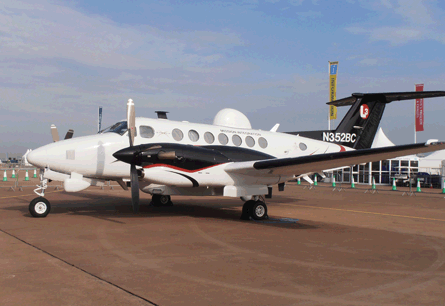L-3 Communications' work to modify a Hawker Beechcraft King Air 350ER for use as a multi-sensor surveillance aircraft will soon see the twin-turboprop's nose section removed.
In its place will be a new structure capable of carrying the weight of an electro-optical/infrared sensor in a ball turret, expected to be an L-3 Wescam MX-15. The modification will increase the King Air's overall length by 0.6m (2ft).
 |
|---|
© Craig Hoyle/Tim Bicheno-Brown/Flightglobal |
Due to appear in its new guise at the Dubai air show in November, Spydr testbed aircraft N352BC made its debut at the Royal International Air Tattoo in the UK in mid-July. The aircraft (below) already has an MX-15 sensor installed beneath its rear fuselage, plus a large fairing above its cabin to accommodate satellite communication equipment.
 |
|---|
© Craig Hoyle/Flightglobal |
Other systems could include a line-of-sight tactical common data link, self-protection equipment, signals intelligence-gathering sensors and a maritime search radar, all integrated with L-3's onboard processing, exploitation and dissemination system.
L-3 is offering potential customers the ability to pick and choose from this menu of options to support a range of military and civilian surveillance applications, from its use as a SIGINT platform to a maritime patrol and fisheries protection asset.
"We want to tailor it for whatever our customers want," Bob Spivey, vice-president, special programmes for the company's Mission Integration Division, said.
Spivey said about 150 aircraft could eventually be sold with Spydr system equipment, which could also be adapted for larger types such as the Alenia Aeronautica C-27J, Bombardier Dash-8 and Lockheed Martin C-130J.
Source: Flight International



















